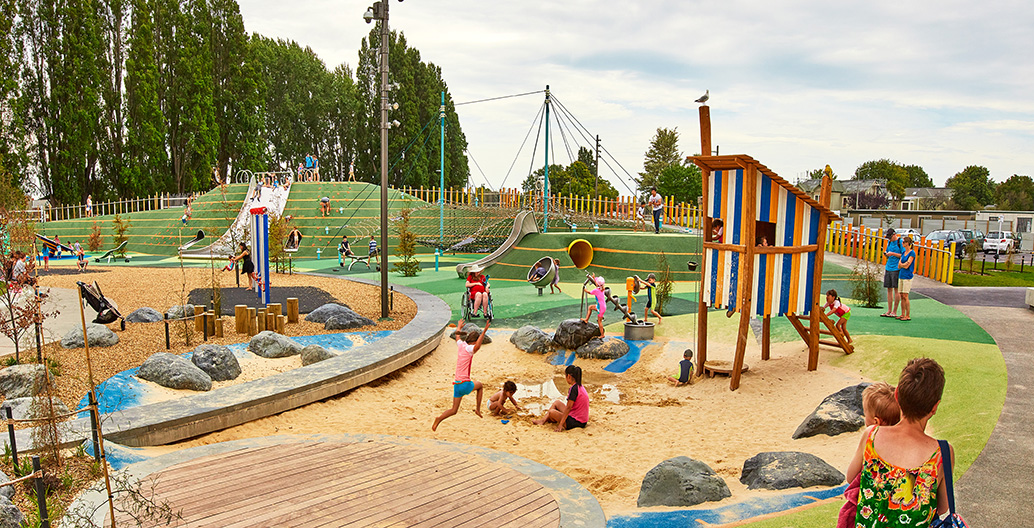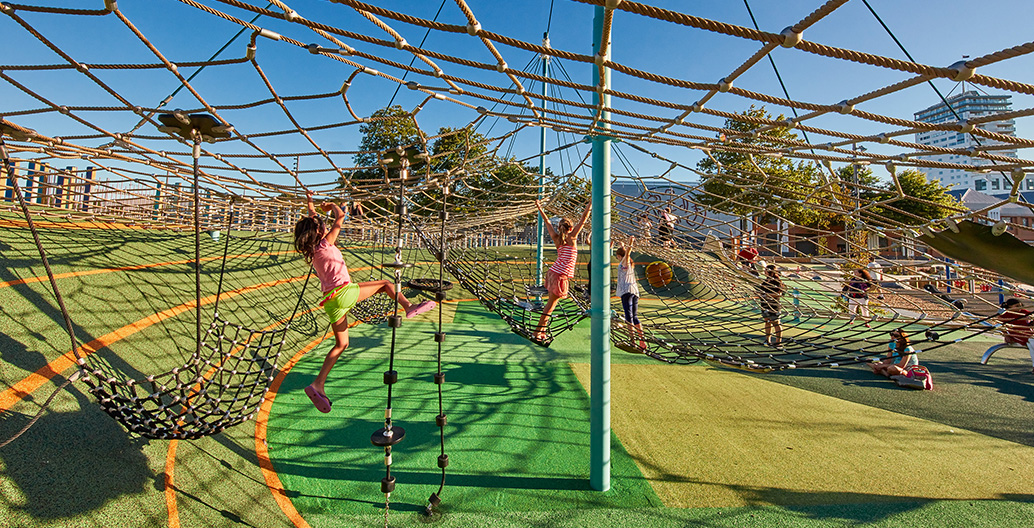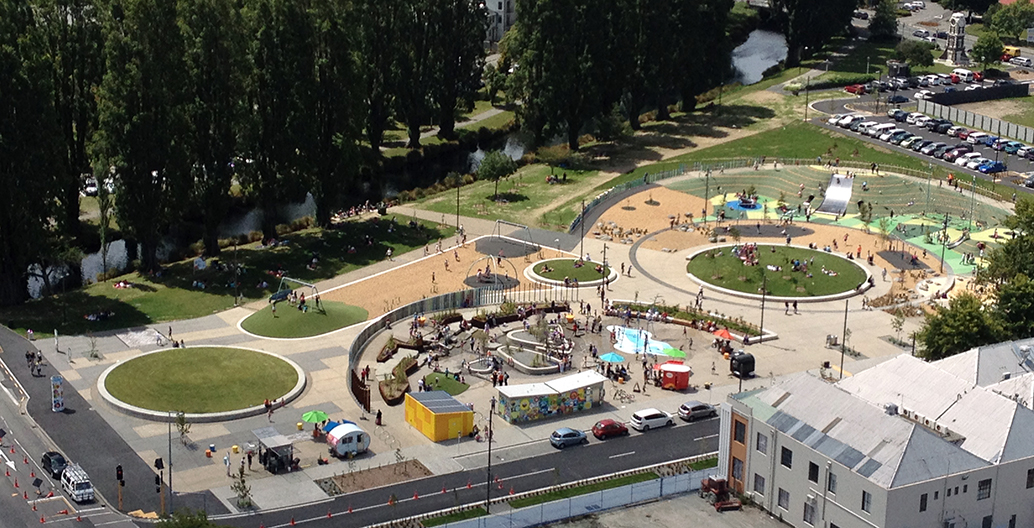
Play with purpose: Christchurch’s transformative new playground
Among the many failures, disappointments and controversies that have beset Christchurch’s post-quake rebuilding, a playground project has brought life, and joy, back into the city.
In December last year, Christchurch’s Margaret Mahy Family Playground – Tākaro ā Poi – opened to the delighted screams of hundreds of children, just two months shy of the fifth anniversary of the earthquake that devastated the city in 2011. On the one hand, this project illustrates many of the things that were wrong with the rebuild; on the other, the outcome is a place of such surprising joy and infectious positive energy it’s hard not to love it. The park involved the demolition of an important community pool, delays, the almost accidental erasure of a memorial to one of Christchurch’s great historical figures Elsie Locke, delays from the discovery of contaminated land, multiple changes in design teams, more delays, and the raising of many eyebrows over the total cost.
At 2.5 acres, the playground is supposedly the biggest in the southern hemisphere and features three, 10-metre-high towers, four different zones (forest, coastal, plains and wetland), a variety of water games, diverse and colourful playground equipment, tunnels, a small café, BBQ area, large slides, and even a flying fox. It’s sited northeast of the Christchurch’s centre, on the edge of the river that meanders right through the city. The playground is designed around pathways that tell the stories of NZ children’s writers and friends Margaret Mahy and Elsie Locke, and stories from Te Rūnanga o Ngāi Tahu (the body that represents the local Māori tribe).

Christchurch's Margaret Mahy Playground.
Bravely for a government project, one of the strengths of the playground is the degree of risky activity it appears to encourage in its (mostly) young visitors. Much of the excitement comes from the colour and dynamism of the design, but a certain special quality comes from the sense of danger and experimentation it is also invites. The actual risk is managed and mitigated so the dangers are minimal in terms of potential harm, but this approach pays dividends. Refreshingly, the playground is intended for all ages and at night is occupied by many adults playing and enjoying the equipment. This reduces the chances of vandalism, and also gives some of the hard working grown-up population a rare chance to play and be silly in a public space.
The idea for a large playground emerged in the consultation process called Share an Idea, run by the Christchurch City Council in 2011. The draft central city plan that developed from this consultation included mention of a large playground. The central government minister in charge of the rebuild, exerting what were called King Henry the VIIIth powers, rejected the Council’s plans in early 2012 and created a new unit to develop a new plan – within 100 days. The 100-day Blueprint, now infamous among locals, was launched in the middle of 2012. It included mention of a large playground to be placed somewhere in a newly-invented ‘green frame’, a swathe of parkland that would provide an eastern edge to the central city while sucking up land to keep property prices from collapsing.
It is worth noting that of the 18 renewal projects the government launched in the wake of the earthquake, the playground was one of the few that had any meaningful community engagement and consultation processes. In 2013, 6000 children from schools across the city were involved in a large design competition. The Amazing Place competition asked the students to design the ‘the world’s best playground’. A range of sketches and suggestions, including naming the park after the important NZ children’s writer Margaret Mahy, were generated by the children and further developed by a design team led by Opus with the design firms Land Lab, Boffa Miskell in collaboration with Christchurch City Council, Te Rūnanga o Ngāi Tahu and playground equipment suppliers Playrope.
The costs are interesting and illustrate the struggles involved. The total cost was NZ$40.9 million (approximately AU$38.1 million at current rates of exchange), with land acquisition accounting for NZ$19.9 million. Demolition and clearing of land cost NZ$1.3 million and ‘development of the block’ (including expensive decontamination) cost NZ$17 million. The playground equipment itself was a modest two to three million.
The city is still less than half built and only four of the 18 large government projects are completed. Five years after the disaster that struck Christchurch, it’s amazing to see hundreds of children running around, playing and laughing in this newly-finished part of the city. It’s particularly odd to think that most of these little people were not born, or have no memory, of the pre-quake city that still looms large in the minds of the rest of population.

Christchurch's Margaret Mahy Playground.
In the darkest and most difficult parts of the rebuild, for many the mantra that ‘we’re doing it for our children and grand-children’ was the motivator that kept them going. Often, this phrase was a cliché, at odds with the narrow environmental vision of the recovery; in this case, it was entirely appropriate. Credit needs to be given here to the project management, design and construction teams for their perseverance. The joy expressed at seeing many children swarm into the ground upon its opening was one of the more beautiful moments of the recovery.
Perhaps quite by accident, the Margaret Mahy Family Playground exemplifies the kinds of participation and consultation demanded in the New Urban Agenda, recently launched at Habitat III. It demonstrates that it is possible to actively design our cities to be inclusive. It also raises the question that, if we want our cities to be inclusive, not just of children, but of a range of diverse users (the elderly, people with disabilities, or people of different cultural backgrounds…), why aren’t we designing them this way? More pointedly, if we aren’t, are we then implicitly designing them out of the city? It is perhaps no surprise that one of the few government projects in the Christchurch rebuild that was designed in genuine consultation with its community of users, is also the one that has brought most joy and life to the city.
Happy children help, too.
Barnaby Bennett is the publisher and co-editor at Freerange Press. He is an award-winning designer and is currently completing a PhD that examines public and temporary architecture in post-quake Christchurch.


